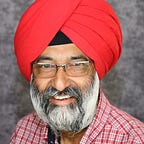My Journey Home: West Punjab — Part 3 of 3
My visit to Nankana Sahib was so memorable. Reading from Siri Guru Granth Sahib installed at the Gurdwara where the first Sikh Guru Sahib was born was priceless. At Nanakana Sahib, I tried to talk with the local Sikhs there in Punjabi but was surprised to learn that they only speak Pashto or Urdu. Later I found out that most Sikhs who now live in West Punjab around historical Gurdwaras are not Punjabi Sikhs — they are Afghani Sikhs who migrated to West Punjab when the Taliban controlled Afghanistan. It was a sad feeling that I had to communicate with my faith’s brethren in Urdu and not our native language of Punjabi.
And then came the visit to Kartarpur Sahib — what an amazing interfaith gift of Pakistanis to Sikhs! I could not imagine such a beautiful place of worship — where Siri Guru Nanak Sahib settled after his travels, farmed here, and passed away here. The complex is huge with the old central shrine intact. I entered the Gurdwara and went upstairs to the worship hall. Half way through the service upstairs I realized there were no Muslims inside the central shrine. On the way out, I approached the Sikh guard and inquired. His response floored me — no Muslims allowed inside the central shrine. I could not believe it — I responded this is not what Siri Guru Nanak Sahib would have wanted. He responded that Muslims take too many photos upstairs. To which I responded that some of the Sikhs who were upstairs with me were no better — they were intrusive in taking photos and videos walking around in between people and pushing and shoving. I felt that photo taking was being used as an excuse to exclude Muslims from entering the central shrine. Now I realized that my Muslim colleagues accompanying me from Lahore had politely volunteered to stay outside — they probably knew the bigoted rule and hence complied nevertheless but I was unaware. The solution is simple — don’t allow photography inside the central shrine as is the rule at Darbar Sahib in Amritsar and many other historical Gurdwaras in East Punjab. I walked out of the central shrine making a pledge to myself that I would not return here till people of all faiths, including Muslims, were allowed equal access as Sikhs — a line in the sand of my own conscience.
After visiting the central shrine at Kartarpur Sahib Gurdwara, I ate and served langar and then headed to an exhibition hall. I was thrilled to see the writing of Afzal Saahir in Gurmukhi in artistic style– one of the best Panjabi poet of West Punjab. I had met him just a few days ago at Lahore’s famous Pak Tea House. Walking through the exhibit a huge Kara (a bracelet which is one of the five articles of the Sikh faith) on sale caught my eye. I could not take my eyes off it. I bought the new Kara. I removed the one I had worn for over 30 years and put on the new one. I offered my old Kara of 30 years to my friend Jahandad Khan who accompanied me on the trip. I offered it to him as a symbol of our friendship and brotherhood knowing well that our ancestors — the Tanoli and Butalia clans — had fought many battles in the early 1800s — on the opposite sides. This was my way of making peace with the past that can still haunt us emotionally. Jahandad graciously accepted it and put it on.
We all believe in stories — some good and some bad. We become the stories we believe in. If you believe in stories of hatred and revenge, that is who you will become. If you choose to believe in stories of love, forgiveness, compassion, and humility — that is who you will develop into. So let us be careful what stories we believe in.
Having been re-born in Lahore and with my journey of coming home to West Punjab ending, as I boarded my return flight, I felt that I was leaving a part of my heart there. And that is what home is — a place where your heart lives.
Borders are man-made arbitrary lines that exist but matter only if you believe in them. Let Punjab be no more divided into Indian Punjab and Pakistani Punjab. The line between East and West Punjab cannot break our friendship and trust of thousands of years — and this is where our hope and future lies.
